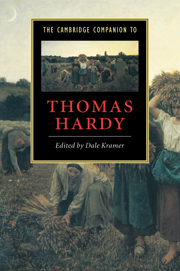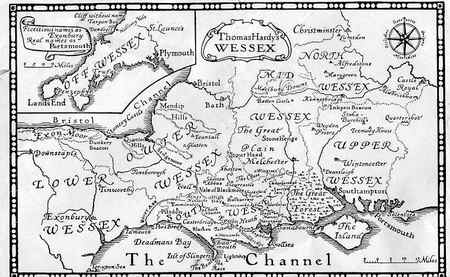tutorial, characters, commentary, and study resources
The Woodlanders. There were no less than ten versions of this novel during Hardy’s lifetime. The first appearance of the text was as a serial which ran in the American magazine Harper’s Bazaar between May 1886 and April 1887 and in Britain in Macmillan’s Magazine at the same time. It was then published as a one-volume novel later in 1887. There followed subsequent editions in England, America, and a ‘colonial’ edition – all of which Hardy edited, making small changes in locations and emphases to the story. There were also numerous pirated editions in America – because International Copyright agreements did not come into effect until 1891.
The Woodlanders – commentary
Melodrama
The crucial dramatic scene in which Grace goes to seek help from Giles is a classic instance of Victorian melodrama writ very heavily indeed. Modern readers can be forgiven for feeling that the situation in the novel at this point has been especially constructed to wring every last drop of pathos from the story.
We know that Giles has been in love with Grace from their earliest days – and has remained loyal to his feelings of respect for her. He has seen her choose Fitzpiers as a husband for reasons of social aspiration, and has simultaneously lost his own precarious social status because his house has been ‘repossessed’. He lives as an outcast, on the fringes of Hintock society, and the repossession of his home is symmetrically in favour of Mrs Charmond, his rival’s lover.
But at this point in the narrative Grace realizes that Giles is a worthy man who she loves after all. Fitzpiers has deserted her with the seductive Felice Charmond and Grace has nobody else to turn to. Fitzpiers returns to Hintock (Felice having been shot in the meantime) hoping for a reconciliation and Grace is in flight from him.
Grace is taken in and protected by Giles, but he is so scrupulous about protecting her reputation he offers to give up his own primitive lodgings and to sleep somewhere else himself. To emphasize his recognition of social boundaries, he even locks her in the house and gives her the key.
Moreover, since Giles is in fact very ill, he protects Grace from the knowledge of his condition by talking to her through a window, so that she will not see his emaciated face. And the somewhere else he goes to sleep is no more than a rustic bivouac which offers him no protection from the storm. As a result of exposure to the rain (on top of his already fevered condition) he dies.
This saintly self-sacrifice may be regarded as a form of voluntary martyrdom on Giles’s part, or alternatively as an almost pathological degree of masochism. The result in either case is the logical extension of such attitudes – which is death.
Literature and morality
It is worth noting that whilst Hardy generally accepted the censorship imposed by publishers, he manages to work into the novel what would be considered at the time a number a risqué scenes.
When Grace meets Felice Charmond when they are both (symbolically?) lost in the woods, Felice reveals the true state of her relations with Grace’s husband Fitzpiers. Hardy has Felice whisper the information (quite unnecessarily) into Grace’s ear – whereupon Grace exclaims ‘O my great God! … He’s had you! Can it be – can it be!’
When Fitzpiers elopes with Mrs Charmond and her divorce is refused, Grace ‘realises’ that she loves Giles after all. So when they meet to consider their bleak future prospects she decides that it would not be wrong to enjoy some sort of physical intimacy with him after all, and she offers herself to him in a manner which would undoubtedly be seen as sexually provocative at the time: “Why don’t you do what you want to?”
Then when Grace is hiding in the cottage she drags Giles’s dying body back into the hut, removes his wet clothes, and puts him into the bed – a scene of intimacy which Hardy emphasises by calling it ‘her bed’.
When Grace miraculously (improbably?) avoids getting caught in the man-trap at the end of the novel, she is forced to remove her skirt in order to escape – immediately after which she decides to give herself up to Fitzpiers again.
Textual history
The genesis of the text presents an interesting picture of authorship and publishing history at the end of the nineteenth century. Hardy might have been frustrated by the prudishness of his publishers (which is one reason why he eventually gave up writing novels) but he took every opportunity to revise his work and to sharpen the focus of his stories, and he was also a practical businessman so far as exploiting the commercial value of his work was concerned. The Woodlanders went through a number of versions before the text was stabilized.
1. The original conception was planned as what he called ‘a woodland story’ in 1874 as a successor to Far from the Madding Crowd, but Hardy put the idea to one side whilst he was writing The Hand of Ethelberta, The Return of the Native, The Trumpet Major, Two on a Tower, and The Mayor of Casterbridge.
2. Ten years later Macmillan’s Magazine wanted a new novel to be serialized. Hardy produced the original manuscript, which is now in the Dorset County Museum.
3. But after revising the galley proofs for Macmillan, Hardy astutely sold the novel to the American magazine Harper’s Bazaar. He revised the version which they serialized and then made more substantial changes to the one-volume version of the novel produced by the parent company Harper and Brothers in 1887.
4. Hardy made further revisions to the galley proofs before returning a third set to Macmillan for their first UK publication between May 1886 and April 1887. [It should be noted that at the time, nobody would be keeping track of all these revisions, ‘improvements’, and changes. That sort of literary scholarship would only come much later.]
5. The first three-volume UK edition of the novel was published by Macmillan in 1887, and at the same time a ‘Colonial’ edition was prepared for sale in the English-speaking colonies such as Canada, Australia, and South-Africa. The purpose of these editions was to reach these outlets first, before the American editions could capture the market.
6. A number of pirated editions also appeared in America – which proves the popularity of Hardy’s work on both sides of the Atlantic. The establishment of International Copyright agreements did not take place until 1891, which helped to put an end to this practice. Hardy naturally had no hand in the preparation of these editions.
7. Hardy changed publisher to Osgood, McIlvaine, who in 1896 issued the collected edition of Hardy’s work called the Wessex Novels. This enabled Hardy to make yet further revisions to the text.
8. But in 1903 Hardy returned to his previous publisher Macmillan, who also wanted to produce a ‘definitive’ edition of Hardy’s work, which they called the ‘Uniform Edition’. Once again, Hardy took the opportunity to revise the text.
9. This process of revisions and new editions continues through Macmillan’s ‘Wessex Editions issued between 1912 and 1914. These are now considered the more or less definitive editions. There was also a commemorative ‘Mellstock Edition’ issued in 1920, but Hardy did not revise the Woodlanders volume.
10. There were two levels of revision made to the work at each of these stages. The first were minor issues of emphasis to the story which Hardy made in response to reader’s criticism. In editing terms, these are called substantives. The second level is matters of punctuation and text presentation (such as capitalization, spelling, speech marks, and italics). These might have been Hardy’s revisions, but they would often be governed by the publisher’s house style.
The Woodlanders – study resources
![]() The Woodlanders – (xford Classics – Amazon UK
The Woodlanders – (xford Classics – Amazon UK
![]() The Woodlanders – Oxford World Classics – Amazon US
The Woodlanders – Oxford World Classics – Amazon US
![]() The Woodlanders – Wordsworth Classics – Amazon UK
The Woodlanders – Wordsworth Classics – Amazon UK
![]() The Woodlanders – Wordsworth Classics – Amazon US
The Woodlanders – Wordsworth Classics – Amazon US
![]() The Complete Works of Thomas Hardy – Kindle eBook
The Complete Works of Thomas Hardy – Kindle eBook
![]() The Woodlanders – eBook formats at Project Gutenberg
The Woodlanders – eBook formats at Project Gutenberg
![]() The Woodlanders – audiobook version at Project Gutenberg
The Woodlanders – audiobook version at Project Gutenberg
![]() The Cambridge Companion to Thomas Hardy – Amazon UK
The Cambridge Companion to Thomas Hardy – Amazon UK
![]() The Complete Critical Guide to Thomas Hardy – Amazon UK
The Complete Critical Guide to Thomas Hardy – Amazon UK
![]() Authors in Context – Thomas Hardy – Amazon UK
Authors in Context – Thomas Hardy – Amazon UK
![]() Oxford Reader’s Companion to Hardy – Amazon UK
Oxford Reader’s Companion to Hardy – Amazon UK
The Woodlanders – principal characters
| Mrs Dollery | a horse drawn van driver |
| Mr Percomb | a master barber |
| Marty South | a young woman who is in love with Giles |
| John South | her father (55) |
| Mrs Felice Charmond | a rich landowner, mistress of Hintock House, a former actress |
| Giles Winterborne | a dealer in apple trees and cider pressing |
| George Melbury | a timber merchant |
| Grace Melbury | his young and educated daughter (20) |
| Mrs Lucy Melbury | his second wife, Grace’s ex-nurse |
| Grammer Oliver | old servant of the Melburys |
| Edred Fitzpiers | a country doctor and would-be scientist |
| Robert Creedle | assistant worker to Giles |
| Suke Damson | a hoyden |
| Tim Tangs | her fiancé, a wood turner |
| Fred Beaucock | an ex lawyer’s clerk |
The Woodlanders – plot summary
Chapter I. Master-barber Percomb gets a lift in Mrs Dollery’s van to Little Hintock.
Chapter II. Percomb tries to persuade Marty South to sell her long chestnut hair, which has been seen and requisitioned by rich landowner Mrs Charmond. He offers Marty two guineas, but she refuses, because she thinks her hair is an essential asset in trying to attract Giles Winterborne.
Chapter III. At night Marty takes the spars she has made to the local timber dealer, George Melbury. There she overhears his worries about his daughter Grace and his plans to marry her to Giles. She goes home and cuts off her hair. In the morning Giles calls for her and they load up the spars.
Chapter IV. Melbury despatches Giles to collect his daughter Grace, who is returning from college. Melbury would like her to marry Giles, even though he doesn’t think him high enough in class terms. He thinks of this as compensation for having won his first wife from Giles’s father.
Chapter V. Giles gives Marty a lift to Sherton Abbas, then is met by Grace. On her way back on foot, Marty is given a lift by Mrs Charmond.
Chapter VI. Giles drives Grace home, trying to revive their past relationship as sweethearts – without success. Grammer Oliver tells Grace about Fitzpiers, a doctor who experiments in science and anatomy who has moved into the locality.
Chapter VII. Giles follows Melbury and Grace into the woods where there is a sale of Mrs Charmond’s timber. Wishing to energize their ‘understood’ engagement, he calls to see Grace, but she is busy getting dressed for a visit to Mrs Charmond.
 Chapter VIII. Grace visits Mrs Charmond in her gloomily placed house and makes a very good impression. Mrs Charmond invites her to be a traveling companion on her planned European tour. Meanwhile, Giles plants fir trees with Marty South.
Chapter VIII. Grace visits Mrs Charmond in her gloomily placed house and makes a very good impression. Mrs Charmond invites her to be a traveling companion on her planned European tour. Meanwhile, Giles plants fir trees with Marty South.
Chapter IX. Giles invites the Melburys and Grace to a Christmas party in the hope of advancing his unofficial engagement with Grace. But his planning is inept, and they turn up far too early.
Chapter X. The party is a mixture of homespun friendliness and social disasters. Giles is chagrined at his failure to impress Grace, and Mr Melbury is ambivalent about Giles as a partner for his daughter.
Chapter XI. Mr Melbury continues to think that having invested a lot of money in Grace’s education, she could marry somebody socially superior to Giles. Yet his conscience troubles him regarding the debt of honour he feels he owes to Giles’s dead father.
Chapter XII. After being insulted by a passing huntsman, Melbury forbids Grace to meet Giles any more. Mrs Charmond is due to leave on her foreign tour, but has not contacted Grace. Meanwhile, Marty’s father John South is dying.
Chapter XIII. John South is worried that a tall tree in his garden might fall on the house and kill him, so Giles prunes the tree. Grace breaks off their engagement, and Mrs Charmond sets off for Italy, without Grace.
Chapter XIV. John South gets worse, so Dr Fitzpiers insists that the tree be cut down. It is done overnight, so as not to alarm South. But next morning the shock of its disappearance kills him.
Chapter XV. Because of old conditions in the house lease (and his father’s negligence) Giles looses the right to his house, which reverts to Mrs Charmond. Giles accepts that his engagement is no longer possible, just as Grace begins to take a renewed romantic interest in him again.
Chapter XVI. Giles meets Dr Fitzpiers and accepts a ride in his gig. Fitzpiers quizzes him about Grace, who he finds attractive. Giles gives away very little information.
Chapter XVII. Grammer Oliver falls ill and reveals to Grace that she has sold her brain to Dr Fitzpiers for ten pounds. Grace is sent to the doctor to cancel the arrangement. Fitzpiers is deeply bored and frustrated with the stagnant social life in the district.
Chapter XVIII. Grace finds Fitzpiers asleep and leaves. He brings her back and agrees to cancel the arrangement with Grammer Oliver. He shows her a fragment of John South’s brain under a microscope.
Chapter XIX. Fitzpiers plans to marry in his own class, but he is attracted to Grace. He thinks she is a rarity with whom he can temporarily amuse himself. He joins the bark-stripping workers, helps Grace find her lost purse, and learns that she as had an ‘admirer’.
Chapter XX. At the Midsummer”s Eve folk rituals Fitzpiers lays ‘claim’ to Grace, displacing Giles. After this he pursues Suke Damson and spends the night with her.
Chapter XXI. Giles is in retreat from the midsummer celebrations when he meets a mysterious stranger from South Carolina who wants to be directed to Mrs Charmond in secrecy.
Chapter XXII. Melbury visits Fitzpiers and agrees to let him pay court to Grace, based on nothing more than a snobbish regard for the doctor’s family name and reputation.
Chapter XXIII. Melbury pressures Grace to accept Fitzpiers so as to enhance her social status. Fitzpiers is accepted by Grace, but he wants a registry office wedding so as to keep her lower class origins quiet.
Chapter XXIV. Grace sees Suke Damson coming out of Fitzpiers’ house at dawn. When confronted by her, he claims it was an emergency medical visit for a tooth extraction. Grace accepts the explanation, but insists on a church wedding. Her wedding dress arrives – and she is married to Fitzpiers.
Chapter XXV. Returning from her honeymoon, Grace meets Giles at an inn, working his cider press. She is upset by the encounter. Grace and Fitzpiers live with the Melburys, but Fitzpiers thinks they ought not to mix socially with her parents. Mrs Charmond sends for Fitzpiers after a fall from her carriage.
Chapter XXVI. Fitzpiers attends Mrs Charmond, who is not hurt at all. She has sent for him because she is bored. It transpires that they have met before, when Fitzpiers was a student in Heidelberg.
Chapter XXVII. Fitzpiers and Mrs Charmond flirt with each other, and he pulls out of the purchase of a medical practice in Budmouth so that he can stay in the vicinity. She decides to go away, but first learns of Giles Winterborne’s plight and feels sympathetic towards him.
Chapter XXVIII. Fitzpiers rides late at night to visit Mrs Charmond in a nearby town. Grace’s suspicions about her husband’s infidelity are confirmed when she meets Giles returning from Middleton Abbey where he has seen both Fitzpiers and Mrs Charmond.
Chapter XXIX. Grace learns that Fitzpiers has lied about extracting Suke Damson’s tooth. Fitzpiers stays out until dawn. Grace retreats from him emotionally, and returns into the parental home. Melbury regrets not having stuck to his original plan of marrying Grace to Giles Winterborne.
Chapter XXX. Melbury begins to spy on Fitzpiers and Mrs Charmond on his daughter’s behalf. Grace bears Fitzpiers’ infidelity without jealousy, largely because she has decided that she loves Giles after all.
Chapter XXXI. Melbury discusses his problems with Giles, revealing his sense of guilt about having been disloyal to the memory of Giles’s father, and wishing that Grace had married Giles. It emerges that Mrs Charmond has been an actress.
Chapter XXXII. Melbury goes to see Mrs Charmond and asks her to have pity on Grace, and to befriend her again so as to quash the scandalous rumours about an illicit relationship with Fitzpiers.
Chapter XXXIII. Grace meets Mrs Charmond in the woods. They argue about Fitzpiers, and Grace predicts that Mrs Charmond will suffer from her love with Fitzpiers. They both get lost in the woods, then find each other again. Mrs Charmond confesses that she loves Fitzpiers and that they are lovers.
Chapter XXXIV. Grace goes to visit friends and falls ill. Her father follows Fitzpiers when he goes to visit Mrs Charmond, but doesn’t get a chance to reproach him for neglecting Grace. Fitzpiers falls off his horse in the dark and is rescued by his father-in-law.
Chapter XXXV. Whilst on Melbury’s horse, Fitzpiers is befuddled by the rum Melbury has given him. He ‘confesses’ his wish to be free to claim Mrs Charmond. Melbury pushes him off his horse, whereupon he bangs his head. Hearing that Fitzpiers has had an accident, Grace, Suke Damson, and Mrs Charmond all assemble in Fitzpiers’ bedroom at the house – but he does not come back home.
Chapter XXXVI. Fitzpiers, his head bleeding, retreats to Mrs Charmond’s house, where she hides him in her attic. He makes plans to ‘disappear’ from Hintock altogether.
Chapter XXXVII. Fitzpiers leaves Hintock, followed closely by Mrs Charmond, and they are later reportedly seen together in Baden. Melbury hears that easier divorce is now possible, and goes to London to arrange a termination of Grace’s and Fitzpiers’ relationship. He also rather precipitately encourages both Giles and Grace to recommence their romance.
Chapter XXXVIII. Giles and Grace meet in Sherton. They re-open their relationship in the Abbey, but are both cautious regarding Grace’s legal position. Giles then blunders socially by ordering her lunch in a workman’s tavern.
Chapter XXXIX. Back in Hintock Giles and Grace are both worried that they might be doing the wrong thing morally. Then Giles gets a letter telling him that the divorce application has failed. He does not reveal this to Grace and accepts her invitation to kiss her. Melbury returns from London with the news that Grace must remain wife to Fitzpiers.
Chapter XL. Three months later, Giles is ill. Grace receives a letter from Fitzpiers asking her to meet at the coast and return with him to France. She refuses, so he comes back to Hintock, where Melbury is prepared to accept him. Grace flees the house and goes to Giles for help.
Chapter XLI. Grace wants to go to the house of a friend, but rain drives them back. She stays in Giles’s cottage whilst he sleeps in a lean-to shelter in the pouring rain. They decide that Grace should hide there. Autumn storms and rain arrive, but Giles remains outside to protect her social reputation.
Chapter XLII. Giles does not appear one morning, and by nightfall Grace is driven out to find him in a delirious state in his shelter. She puts him to bed, then goes to summon the nearest doctor – who is Fitzpiers.
Chapter XLIII. Fitzpiers arrives at the cottage and confirms that Giles is dying – which he does. Grace lets Fitzpiers believe that she has been living in the cottage with Giles as lovers. He reveals to her that Mrs Charmond is dead. [She was shot by a jealous lover.] Marty South appears, and the two women pray for Giles. Mr and Mrs Melbury arrive and take Grace back home – on her condition that Fitzpiers leaves.
Chapter XLIV. Grace and Marty visit Giles’s grave, and Fitzpiers visits Hintock, learning from Marty the truth about Grace’s occupation of the cottage.
Chapter XLV. Some months later Fitzpiers writes to Grace asking to see her again. When they meet he wants to be forgiven and live together again. She does not accede to the idea, and asks her father for advice. He says she is better off without Fitzpiers.
Chapter XLVI. Fitzpiers visits Grace in her garden and presses his case again. She tells him she will remain loyal to the memory of Giles. Meanwhile Tom Tangs is suspicious of Suke’s interest in Fitzpiers, and wishes to strike back against him on the eve of his departure for New Zealand.
Chapter XLVII. Tangs sets a huge man-trap for Fitzpiers on the night he is due to visit Grace. But Grace’s skirt is caught in it when she gets to the spot first. Fitzpiers has bought into a medical practice in the midlands with money from an inheritance. He presses his argument for reconciliation harder than ever.
Chapter XLVIII. Grace submits and returns to Sherton with Fitzpiers. Melbury goes with friends in search of his daughter and finds her at the inn. On their return to Hintock, they pass Marty who is tending Giles’ grave alone, now ‘united’ with the man she loved.
Hardy’s study
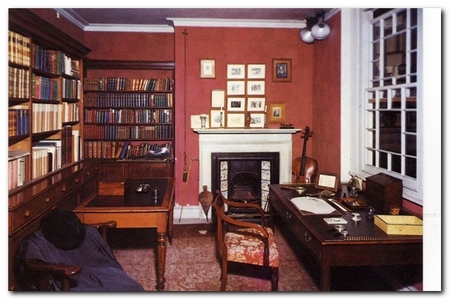
reconstructed in Dorchester museum
The Woodlanders – bibliography
John Bayley, ‘A Social Comedy’ On Re-Reading The Woodlanders, Thomas Hardy Annual, 5 (1987), 3-21.
Penny Boumelha, ‘The Patriarchy of Class: Under the Greenwood Tree, Far from the Madding Crowd, The Woodlanders‘. in Dale Kramer (ed.), The Cambridge Companion to Thomas Hardy (Cambridge: Cambridge University Press, 1999), 130-44.
Peter Casagrande Jr., ‘The Shifted “Centre of Altruism” in The Woodlanders: Thomas Hardy’s Third “Return of the Native”‘, Journal of English Literary History 38 (1971), 104-25.
Annette Frederico, ‘Pathalogical Gentlemen: Far from the Madding Crowd and The Woodlanders‘, in her Masculine Identity in Hardy and Gissing (London and Toronto, Associated University Presses, 1991), 55-75.
Frank R. Giordano, ‘The Martyrdom of Giles Winterborne’, Thoma Hardy Annual, 2 (1984), 61-78.
Patricia Ingham, ‘Introduction’, in Thomas Hardy, The Woodlanders, ed. P. Ingham (London: Penguin, 1998).
Mary Jacobus, ‘Tree and Machine: The Woodlanders‘, in Dale Kramer (ed.), Critical Approaches in the Fiction of Thomas Hardy (London: Macmillan, 1979), 116-34.
Rosemary Sumner, A Route to Modernism: Hardy, Lawrence, Woolf (Basingstoke: Macmillan, 1999).
Richard H. Taylor, The Neglected Hardy: Thomas Hardy’s Lesser Novels (Basingstoke: Macmillan 1982).
Jane Thomas, Thomas Hardy, Femininity and Dissent: Reassessing the Minor Novels (Basingstoke: Macmillan, 1999).
Hardy’s WESSEX
The Woodlanders – further reading
![]() John Bayley, An Essay on Hardy, Cambridge: Cambridge University Press, 1978.
John Bayley, An Essay on Hardy, Cambridge: Cambridge University Press, 1978.
![]() Penny Boumelha, Thomas Hardy and Women: Sexual Ideology and Narrative Form, Brighton: Harvester, 1982.
Penny Boumelha, Thomas Hardy and Women: Sexual Ideology and Narrative Form, Brighton: Harvester, 1982.
![]() Kristin Brady, The Short Stories of Thomas Hardy, London: Macmillan, 1982.
Kristin Brady, The Short Stories of Thomas Hardy, London: Macmillan, 1982.
![]() L. St.J. Butler, Alternative Hardy, London: Macmillan, 1989.
L. St.J. Butler, Alternative Hardy, London: Macmillan, 1989.
![]() Raymond Chapman, The Language of Thomas Hardy, London: Macmillan, 1990.
Raymond Chapman, The Language of Thomas Hardy, London: Macmillan, 1990.
![]() R.G.Cox, Thomas Hardy: The Critical Heritage, London: Routledge and Keegan Paul, 1970.
R.G.Cox, Thomas Hardy: The Critical Heritage, London: Routledge and Keegan Paul, 1970.
![]() Ralph W.V. Elliot, Thomas Hardy’s English, Oxford: Basil Blackwell, 1984.
Ralph W.V. Elliot, Thomas Hardy’s English, Oxford: Basil Blackwell, 1984.
![]() James Gibson (ed), The Complete Poems of Thomas Hardy, London, 1976.
James Gibson (ed), The Complete Poems of Thomas Hardy, London, 1976.
![]() Florence Emily Hardy, The Life of Thomas Hardy, London: Macmillan, 1962. (This is more or less Hardy’ s autobiography, since he told his wife what to write.)
Florence Emily Hardy, The Life of Thomas Hardy, London: Macmillan, 1962. (This is more or less Hardy’ s autobiography, since he told his wife what to write.)
![]() P. Ingham, Thomas Hardy: A Feminist Reading, Brighton: Harvester, 1989.
P. Ingham, Thomas Hardy: A Feminist Reading, Brighton: Harvester, 1989.
![]() P.Ingham, The Language of Class and Gender: Transformation in the English Novel, London: Routledge, 1995,
P.Ingham, The Language of Class and Gender: Transformation in the English Novel, London: Routledge, 1995,
![]() Michael Millgate, Thomas Hardy: His Career as a Novelist, London: Bodley Head, 1971.
Michael Millgate, Thomas Hardy: His Career as a Novelist, London: Bodley Head, 1971.
![]() Michael Millgate, Thomas Hardy: A Biography Revisited, Oxford: Clarendon Press, 2006. (This is the definitive biography.)
Michael Millgate, Thomas Hardy: A Biography Revisited, Oxford: Clarendon Press, 2006. (This is the definitive biography.)
![]() Michael Millgate and Richard L. Purdy (eds), The Collected Letters of Thomas Hardy, Oxford: Clarendon Press, 1978-
Michael Millgate and Richard L. Purdy (eds), The Collected Letters of Thomas Hardy, Oxford: Clarendon Press, 1978-
![]() R. Morgan, Women and Sexuality in the Novels of Thomas Hardy, London: Routledge, 1988.
R. Morgan, Women and Sexuality in the Novels of Thomas Hardy, London: Routledge, 1988.
![]() Harold Orel (ed), Thomas Hardy’s Personal Writings, London, 1967.
Harold Orel (ed), Thomas Hardy’s Personal Writings, London, 1967.
![]() F.B. Pinion, A Thomas Hardy Companion, London: Macmillan, 1968.
F.B. Pinion, A Thomas Hardy Companion, London: Macmillan, 1968.
![]() Norman Page, Thomas Hardy, London: Routledge & Keegan Paul, 1977.
Norman Page, Thomas Hardy, London: Routledge & Keegan Paul, 1977.
![]() Rosemary Sumner, Thomas Hardy: Psychological Novelist, London: Macmillan, 1981.
Rosemary Sumner, Thomas Hardy: Psychological Novelist, London: Macmillan, 1981.
![]() Richard H. Taylor, The Personal Notebooks of Thomas Hardy, London, 1978.
Richard H. Taylor, The Personal Notebooks of Thomas Hardy, London, 1978.
![]() Merryn Williams, A Preface to Hardy, London: Longman, 1976.
Merryn Williams, A Preface to Hardy, London: Longman, 1976.
Other works by Thomas Hardy
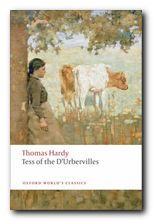 Tess of the d’Urbervilles (1891) is probably the most popular of Hardy’s late, great novels. The sub-title is ‘A Pure Woman’, and it is a story which explores the tragic consequences of a young milkmaid who becomes the victim of the men she encounters. First she falls for the spiritual but flawed Angel Clare, and then the physical but limited Alec Durberville takes advantage of her. This novel has some of the most beautiful and the most harrowing depictions of rural working conditions which reveal Hardy as a passionate advocate for those who work the land. It also has a wonderfully symbolic climax at Stonehenge on Salisbury Plain. There is poetry in almost every page.
Tess of the d’Urbervilles (1891) is probably the most popular of Hardy’s late, great novels. The sub-title is ‘A Pure Woman’, and it is a story which explores the tragic consequences of a young milkmaid who becomes the victim of the men she encounters. First she falls for the spiritual but flawed Angel Clare, and then the physical but limited Alec Durberville takes advantage of her. This novel has some of the most beautiful and the most harrowing depictions of rural working conditions which reveal Hardy as a passionate advocate for those who work the land. It also has a wonderfully symbolic climax at Stonehenge on Salisbury Plain. There is poetry in almost every page.
![]() Buy the book at Amazon UK
Buy the book at Amazon UK
![]() Buy the book at Amazon US
Buy the book at Amazon US
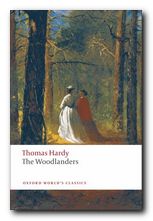 The Woodlanders (1887) Giles Winterbourne, an honest woodsman, suffers with the many tribulations of his selfless love for Grace Melbury, a woman above his station in this classic tale of the West Country. She marries the new doctor, Edred Fitzpiers, but leaves him when she learns he has been unfaithful. She turns instead to Giles, who nobly allows her to sleep in his house during stormy weather, whilst he sleeps outside and brings on his own death. It’s often said that the hero of this novel is the woods themselves – so deeply moving is Hardy’s account of the timbered countryside which provides the backdrop for another human tragedy and a study of rural life in transition.
The Woodlanders (1887) Giles Winterbourne, an honest woodsman, suffers with the many tribulations of his selfless love for Grace Melbury, a woman above his station in this classic tale of the West Country. She marries the new doctor, Edred Fitzpiers, but leaves him when she learns he has been unfaithful. She turns instead to Giles, who nobly allows her to sleep in his house during stormy weather, whilst he sleeps outside and brings on his own death. It’s often said that the hero of this novel is the woods themselves – so deeply moving is Hardy’s account of the timbered countryside which provides the backdrop for another human tragedy and a study of rural life in transition.
![]() Buy the book at Amazon UK
Buy the book at Amazon UK
![]() Buy the book at Amazon US
Buy the book at Amazon US
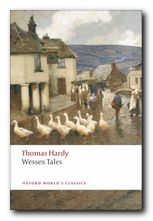 Wessex Tales Don’t miss the skills of Hardy as a writer of shorter fictions. None of his short stories are really short, but they are beautifully crafted. This is the first volume of his tales in which he was seeking to record the customs, superstitions, and beliefs of old Wessex before they were lost to living memory. Yet whilst dealing with traditional beliefs, they also explore very modern concerns of difficult and often thwarted human passions which he developed more extensively in his longer works.
Wessex Tales Don’t miss the skills of Hardy as a writer of shorter fictions. None of his short stories are really short, but they are beautifully crafted. This is the first volume of his tales in which he was seeking to record the customs, superstitions, and beliefs of old Wessex before they were lost to living memory. Yet whilst dealing with traditional beliefs, they also explore very modern concerns of difficult and often thwarted human passions which he developed more extensively in his longer works.
![]() Buy the book at Amazon UK
Buy the book at Amazon UK
![]() Buy the book at Amazon US
Buy the book at Amazon US
Thomas Hardy – web links
Thomas Hardy at Mantex
Biographical notes, study guides to the major novels, book reviews. bibliographies, critiques of the shorter fiction, and web links.
The Thomas Hardy Collection
The complete novels, stories, and poetry – Kindle eBook single file download for £1.29 at Amazon.
Thomas Hardy at Project Gutenberg
A major collection of free eTexts in a variety of digital formats.
Thomas Hardy at Wikipedia
Biographical notes, social background, the novels and literary themes, poetry, religious beliefs and influence, biographies and criticism.
The Thomas Hardy Society
Dorset-based site featuring educational activities, a biennial conference, a journal (three times a year) with links to the texts of all the major works.
The Thomas Hardy Association
American-based site with photos and academic resources. Be prepared to search and drill down to reach the more useful materials.
Thomas Hardy on the Internet Movie Database
Adaptations for the cinema and television – in various languages. Full details of directors, actors, production features, box office, film reviews, and even quizzes.
Thomas Hardy – online literary criticism
Small collection of academic papers and articles ‘favoring signed articles by recognized scholars and articles published in peer-reviewed sources’.
Thomas Hardy’s Wessex
Evolution of Wessex, contemporary reviews, maps, bibliography, links to other web sites, and history.
© Roy Johnson 2013
More on Thomas Hardy
More on the novella
More on literary studies
More on short stories

